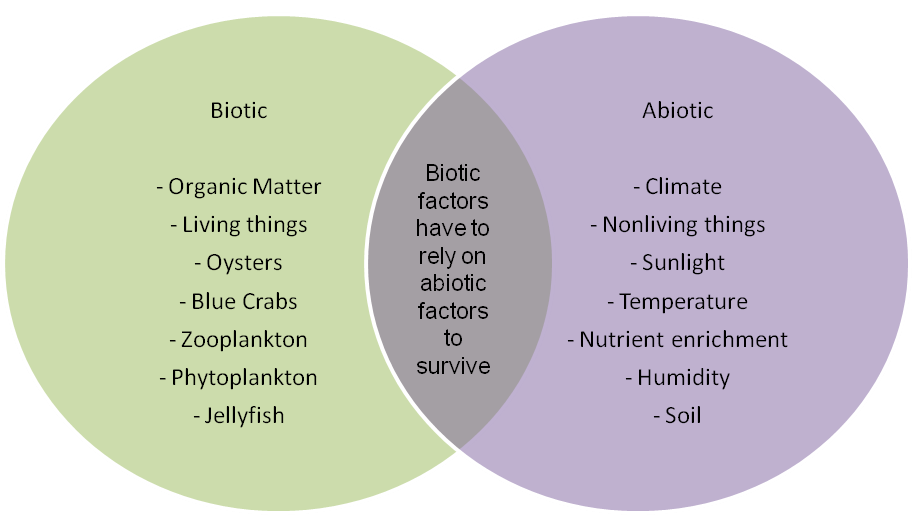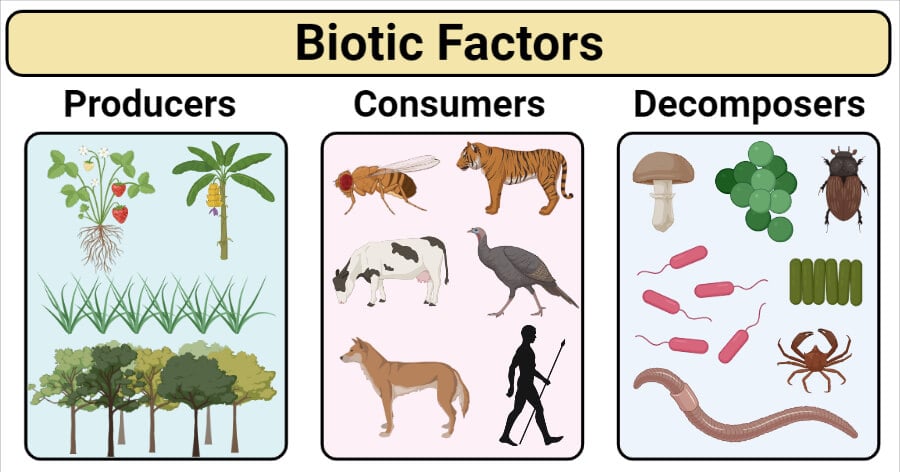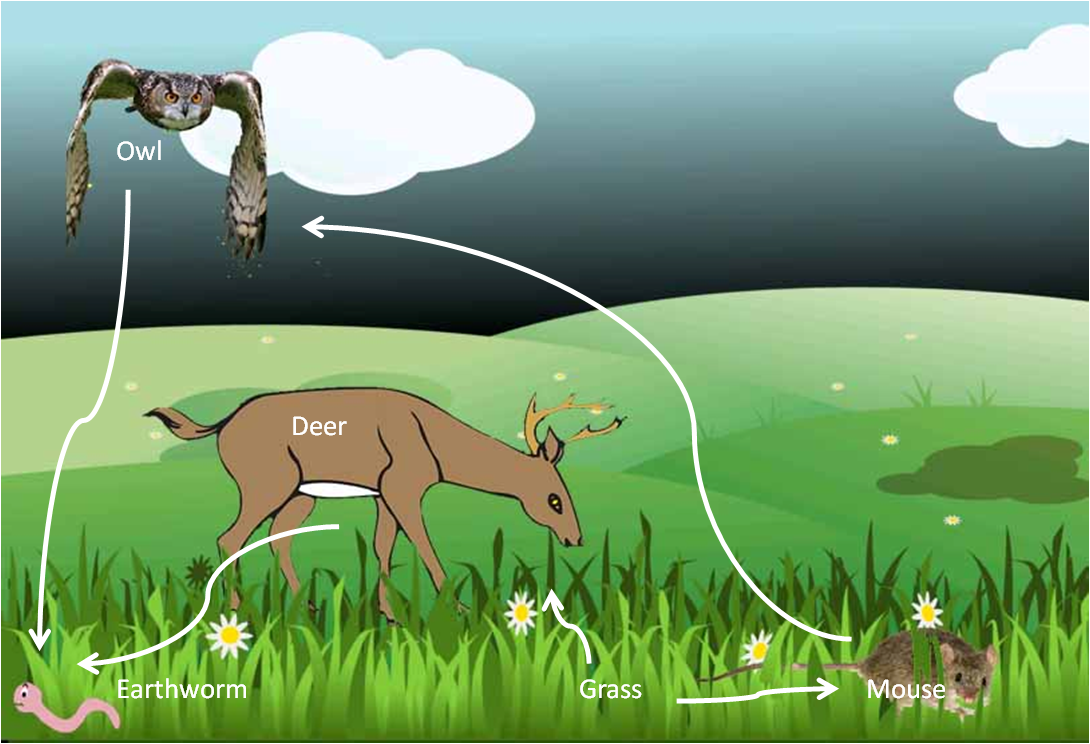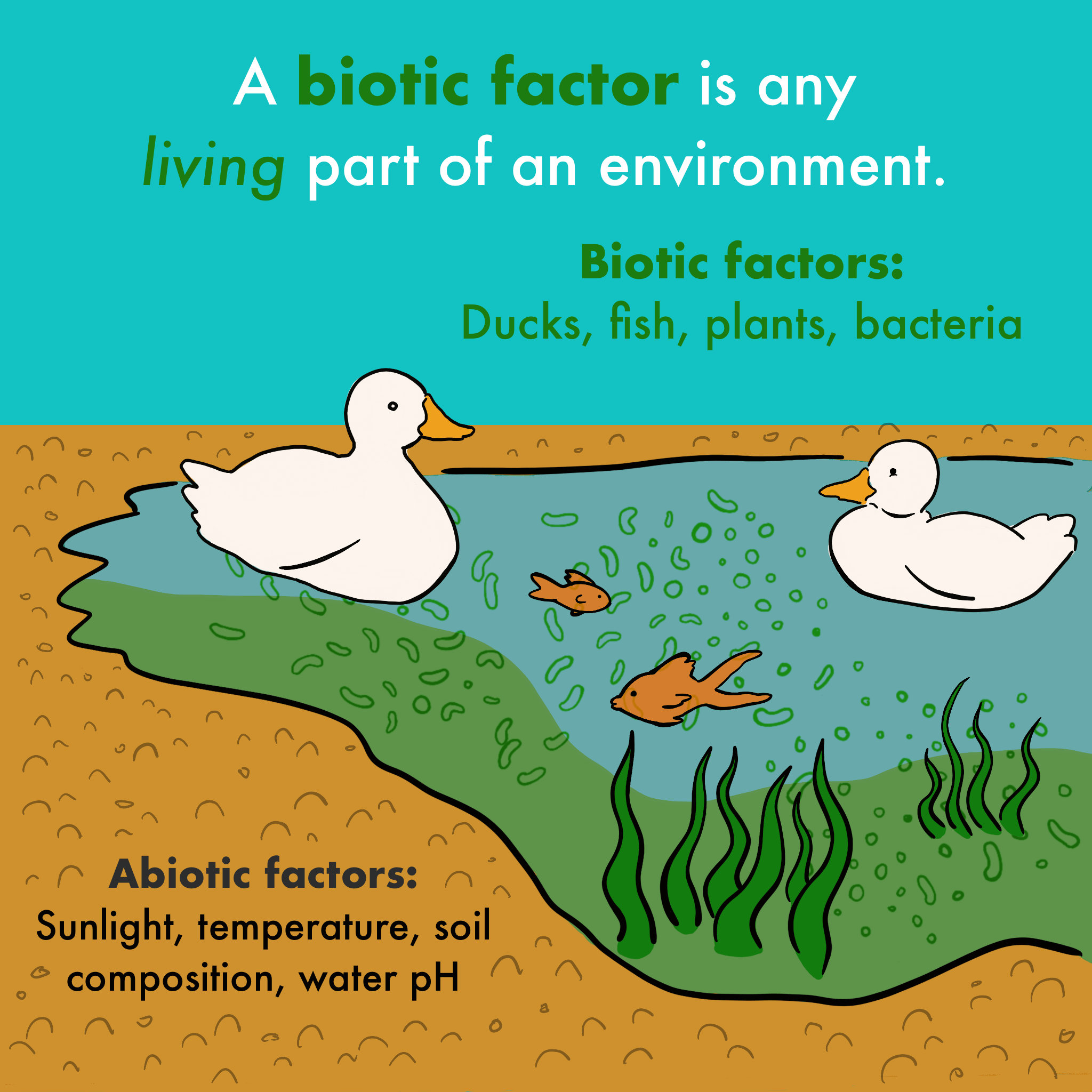Topic biotic factors in an ecosystem examples: Explore the vibrant world of biotic factors in ecosystems, where plants, animals, and microorganisms play pivotal roles in maintaining biodiversity and ecological balance.
Table of Content
- What are some examples of biotic factors in an ecosystem?
- Understanding Biotic Factors
- Types of Biotic Factors
- Examples of Biotic Factors
- Role of Producers in Ecosystems
- Consumers: Herbivores, Carnivores, and Omnivores
- Decomposers and Detritivores: Nature"s Recyclers
- YOUTUBE: Biotic and Abiotic Factors
- Interaction Between Biotic and Abiotic Factors
- Influence of Biotic Factors on Ecosystem Dynamics
- Case Studies: Biotic Factors in Different Ecosystems
- Conservation Efforts and Biotic Factors
What are some examples of biotic factors in an ecosystem?
Examples of biotic factors in an ecosystem:
- Animals - This includes various species of mammals, birds, reptiles, amphibians, and insects. They play a crucial role in the ecosystem by interacting with other organisms and influencing the food chain.
- Plants - The presence of different plant species is a significant biotic factor. Trees, grasses, shrubs, and other plants provide food, shelter, and support for many organisms in the ecosystem.
- Bacteria - Bacteria are microscopic organisms that can be found in soil, water, and even within other living organisms. They play important roles in nutrient cycling and decomposition.
- Fungi - Fungi, such as mushrooms and molds, are vital components of ecosystems. They aid in decomposition, assist in nutrient cycling, and form mutualistic relationships with other organisms.
- Protists - Protists are single-celled organisms that can be found in water bodies. They serve as a food source for many organisms and are important contributors to the ecosystem\'s biodiversity.
These examples demonstrate the diverse array of biotic factors that interact within an ecosystem, highlighting the interconnectedness of living organisms and their impact on the environment.
READ MORE:
Understanding Biotic Factors
Biotic factors refer to the living components within an ecosystem that affect both the environment and other organisms. These factors are essential for the survival and growth of organisms, as they directly or indirectly influence their lives and the overall health of the ecosystem.
- Definition: Biotic factors are all the living elements of an ecosystem, including plants, animals, fungi, and microorganisms.
- Importance: They play crucial roles in the ecosystem such as producers, consumers, and decomposers, contributing to energy flow and nutrient cycling.
- Interaction: Biotic factors interact with each other and with abiotic factors (non-living elements) to sustain life processes.
- Diversity: The variety of biotic factors contributes to biodiversity, which is vital for ecosystem resilience and adaptability.
- Impact: Changes in the biotic components can significantly affect the structure and function of an ecosystem, highlighting the importance of conservation and sustainable practices.
Understanding biotic factors and their roles within ecosystems is fundamental for environmental science and conservation efforts, enabling us to better appreciate the intricate connections that sustain life on Earth.

Types of Biotic Factors
Biotic factors, the living components of an ecosystem, play a crucial role in shaping the environment and the interactions within it. These factors can be broadly categorized into three main types: producers, consumers, and decomposers. Each category plays a unique role in the ecosystem, contributing to the flow of energy and the cycling of nutrients.
- Producers (Autotrophs): These are organisms that synthesize their own food from inorganic substances using light or chemical energy. Plants, algae, and some bacteria fall into this category. They are the foundation of the food web, providing energy for all other organisms in the ecosystem.
- Consumers (Heterotrophs): Consumers are organisms that cannot produce their own food and need to consume other organisms for energy. They are classified into several types based on their diet:
- Herbivores: Animals that feed primarily on plants (e.g., deer, rabbits).
- Carnivores: Animals that eat other animals (e.g., lions, hawks).
- Omnivores: Animals that consume both plants and animals (e.g., humans, bears).
- Parasites: Organisms that live on or inside other living organisms (hosts), causing them harm (e.g., tapeworms, fleas).
- Decomposers and Detritivores: These organisms break down dead organic matter, returning nutrients to the soil and making them available for use by producers. Decomposers include fungi and bacteria, while detritivores (a type of consumer that feeds on dead matter) include earthworms and certain types of insects.
The interaction among these biotic factors, along with abiotic factors like sunlight, water, and soil, determines the health and sustainability of the ecosystem. Understanding the roles and relationships of these biotic components is essential for the study of ecology and the conservation of biodiversity.
Examples of Biotic Factors
Biotic factors encompass all living organisms in an ecosystem that interact with each other and their environment. These factors are diverse, ranging from microscopic bacteria to large mammals, and play various roles within their ecosystems. Below are examples of biotic factors, illustrating the complexity and variety of life forms contributing to ecological systems.
- Plants: Trees in a forest, grass in a meadow, algae in a pond. Plants are primary producers, converting sunlight into energy through photosynthesis, serving as the foundation of most food chains.
- Animals: Birds, fish, mammals, insects, and reptiles. These vary from primary consumers (herbivores) to secondary and tertiary consumers (carnivores and omnivores) that feed on other organisms.
- Microorganisms: Bacteria, fungi, and viruses. These play critical roles in nutrient cycling, decomposing organic matter, and even in the health and disease of other organisms.
- Fungi: Mushrooms, mold, and yeast. Fungi act as decomposers, breaking down dead organic material and recycling nutrients back into the ecosystem.
- Insects: Bees, ants, butterflies, and beetles. Insects can be pollinators, herbivores, carnivores, or decomposers, showcasing the wide range of roles that biotic factors can play.
These examples highlight the interconnectedness of biotic factors within ecosystems. The presence, abundance, and health of these organisms directly impact the structure and function of their habitats, influencing everything from nutrient cycling to the overall biodiversity of the area.

Role of Producers in Ecosystems
Producers, or autotrophs, are the cornerstone of ecosystems, playing a vital role in the energy flow and nutrient cycle. These organisms are capable of synthesizing their own food from inorganic substances using light (photosynthesis) or chemical energy (chemosynthesis), forming the base of the food web. The following points highlight the critical role of producers in ecosystems:
- Energy Conversion: Producers convert solar energy into chemical energy through photosynthesis. This energy becomes available to other organisms in the ecosystem when they consume plants or the animals that feed on plants.
- Oxygen Production: Through photosynthesis, producers release oxygen into the atmosphere, which is essential for the survival of aerobic life forms, including humans.
- Food Source: They serve as the primary food source for consumers, including herbivores, which are the second level in the food chain, and indirectly support carnivores and omnivores.
- Nutrient Cycling: Producers play a key role in nutrient cycling by assimilating inorganic nutrients from the soil and atmosphere, converting them into organic forms that can be used by other organisms.
- Habitat Formation: Many producers, especially plants, create habitats for numerous organisms. Forests, grasslands, and aquatic vegetation are examples of ecosystems structured around producer organisms, offering shelter, breeding grounds, and food.
The role of producers extends beyond mere food provision; they are fundamental in maintaining the balance of ecosystems, influencing the availability of resources, and supporting biodiversity. By sustaining the base of the food web, producers ensure the survival of a wide array of species and the proper functioning of the ecosystem as a whole.
Consumers: Herbivores, Carnivores, and Omnivores
Consumers play a pivotal role in ecosystems by transferring energy from one trophic level to the next. Unlike producers, consumers cannot synthesize their own food and must obtain energy by consuming other organisms. They are classified into three main categories based on their diet: herbivores, carnivores, and omnivores, each playing a unique role in the food web.
- Herbivores: Herbivores are consumers that feed exclusively on plant material. They are the primary consumers in the food chain, directly transferring energy from producers to higher trophic levels. Examples include deer, elephants, and caterpillars. Herbivores play a crucial role in controlling plant populations and facilitating energy transfer to carnivores and omnivores.
- Carnivores: Carnivores are predators that consume other animals. They can be secondary consumers (eating herbivores) or tertiary consumers (eating other carnivores). Examples include lions, wolves, and eagles. Carnivores help regulate the populations of other species, maintaining ecological balance by preventing overpopulation and disease spread.
- Omnivores: Omnivores can digest both plant and animal matter. Their flexibility in diet allows them to consume food at multiple trophic levels. Examples include humans, bears, and pigs. Omnivores contribute to the energy flow across different parts of the ecosystem, acting as both predators and prey within the food web.
Consumers are essential for the sustainability of ecosystems. They control the population sizes of their prey, contribute to the cycling of nutrients by breaking down the bodies of consumed organisms, and serve as a food source for other predators and decomposers. Understanding the dynamics of consumer interactions helps in comprehending the complexity of food webs and the overall health of ecosystems.

Decomposers and Detritivores: Nature"s Recyclers
Decomposers and detritivores are essential biotic factors in ecosystems, playing the critical role of breaking down dead organic matter and recycling nutrients back into the environment. These organisms ensure the continuation of life by converting waste materials into forms that can be reused by producers, thus maintaining the nutrient cycles.
- Decomposers: Decomposers, such as fungi and bacteria, break down dead organic material at the molecular level, converting it into inorganic substances. These microorganisms play a crucial role in nutrient cycling by decomposing dead plants and animals, releasing carbon, nitrogen, and other elements back into the soil and air, where they can be taken up by plants.
- Detritivores: Detritivores, including earthworms, woodlice, and dung beetles, physically break down dead organisms and waste products into smaller pieces. This process not only helps in the initial breakdown of organic material but also makes it more accessible to decomposers for further decomposition.
The work of decomposers and detritivores is fundamental to ecosystem health and sustainability. Without these organisms, ecosystems would be overwhelmed with the accumulation of dead material, and the recycling of nutrients would be halted, leading to decreased soil fertility and the disruption of plant and animal communities. By converting dead and decaying matter into nutrient-rich soil, decomposers and detritivores support the growth of plants and the continuation of the food web.
Biotic and Abiotic Factors
Discover the wonders of the ecosystem as we take you on a captivating visual journey through lush forests, sparkling rivers, and vibrant coral reefs. Unlock the secrets of nature\'s intricate web of life in this mesmerizing video that will leave you in awe of our planet\'s incredible biodiversity.
GCSE Biology - Biotic and Abiotic Factors
Get ahead in your GCSE Biology studies with this engaging video that breaks down complex concepts into simple, easy-to-understand explanations. Our expert tutor will guide you through key topics, making learning fun and enjoyable. Prepare for your exams with confidence and achieve the grades you\'ve always dreamed of with this comprehensive video resource.
Interaction Between Biotic and Abiotic Factors
The dynamics of ecosystems are shaped by the intricate interactions between biotic (living) and abiotic (non-living) factors. These interactions are fundamental to the functioning of ecosystems, influencing the distribution, behavior, and survival of organisms. Understanding these relationships is key to appreciating how ecosystems operate and the importance of maintaining balance within them.
- Photosynthesis and Light: The process of photosynthesis in plants, a biotic factor, is directly influenced by sunlight, an abiotic factor. Sunlight"s intensity and duration affect the rate of photosynthesis, which in turn determines the amount of energy produced and available within an ecosystem.
- Soil and Plant Growth: The quality and type of soil, an abiotic factor, significantly affect the types of plants (biotic factor) that can grow in an ecosystem. Soil nutrients, pH, and texture determine plant health, distribution, and the structure of plant communities.
- Water Availability: Water, an abiotic factor, is crucial for all living organisms. Its availability influences the distribution and types of organisms (biotic factors) that can exist in an area. For instance, aquatic and semi-aquatic species are predominantly found in or near water bodies.
- Temperature: Temperature, another abiotic factor, governs the survival of organisms. Different species (biotic factors) have varying temperature ranges within which they can survive, grow, and reproduce, affecting their geographical distribution and seasonal behaviors.
- Predation and Habitat: The interaction between predators and prey (biotic factors) is influenced by the availability of cover and the type of terrain (abiotic factors), which can affect hunting and evasion strategies.
These interactions underscore the balance necessary for ecosystem health and stability. Abiotic factors provide the conditions under which living organisms operate, while biotic factors contribute to the structure and function within those conditions. The interplay between these factors drives the complexity and diversity of ecosystems around the world.

Influence of Biotic Factors on Ecosystem Dynamics
Biotic factors, the living components of an ecosystem, significantly influence its structure, function, and overall dynamics. These factors include a wide range of organisms such as plants, animals, fungi, and microorganisms, each playing specific roles that contribute to the ecosystem"s health and sustainability. The influence of biotic factors on ecosystem dynamics is multifaceted and critical for ecological balance.
- Population Control: Predation, disease, and competition among species (biotic factors) help regulate population sizes, preventing any one species from dominating the ecosystem. This balance ensures resource availability and biodiversity.
- Nutrient Cycling: Decomposers and detritivores break down dead organic matter, returning nutrients to the soil where they can be reused by producers. This cycling of nutrients is vital for plant growth and the continuation of the food web.
- Pollination and Seed Dispersal: Animals, birds, and insects (biotic factors) play crucial roles in pollinating plants and dispersing seeds, aiding in plant reproduction and the spread of various plant species across the ecosystem.
- Habitat Modification: Organisms such as beavers, which build dams, or plants that alter the soil pH, can significantly change their environment, creating new habitats for other organisms and influencing the physical structure of the ecosystem.
- Succession: The presence and activities of certain species can influence ecological succession, the process by which the structure of a biological community evolves over time. For example, pioneer species can colonize barren environments, gradually making them habitable for other species.
The dynamic interactions and feedback loops between biotic factors drive ecosystem processes, including energy flow, climate regulation, and the maintenance of biodiversity. The resilience and stability of ecosystems depend on these complex interactions and the diversity of life they support. Understanding the influence of biotic factors on ecosystem dynamics is essential for conservation efforts and the sustainable management of natural resources.
Case Studies: Biotic Factors in Different Ecosystems
Ecosystems around the world vary greatly, each with its own unique set of biotic factors that contribute to its structure and function. The following case studies highlight the role of biotic factors in different ecosystems, showcasing the diversity of life and the complex interactions that sustain these environments.
- Tropical Rainforest Ecosystem: In the Amazon rainforest, the vast diversity of plants provides habitat and food for millions of species. Large trees, such as the Ceiba and the Kapok, offer structure for the ecosystem, while countless insect species, including bees and butterflies, facilitate pollination, supporting plant diversity. Primates and birds, such as toucans and parrots, play critical roles in seed dispersal.
- Coral Reef Ecosystem: The Great Barrier Reef demonstrates the importance of coral polyps, tiny organisms that build calcium carbonate structures. These corals form the basis of the reef ecosystem, providing habitat for a multitude of fish, crustaceans, and mollusks. Fish species, such as clownfish and parrotfish, not only contribute to the diversity but also to the nutrient cycling and the health of coral reefs.
- Grassland Ecosystem: In the Serengeti Plains, vast herds of herbivores, including wildebeest, zebras, and gazelles, graze on grasses and small shrubs. These herbivores are crucial for maintaining grassland health by preventing overgrowth and providing nutrients through their waste. Predators like lions and hyenas control the herbivore populations, ensuring a balanced ecosystem.
- Desert Ecosystem: In the Sahara Desert, biotic factors such as date palms and cacti have adapted to the arid conditions, providing food and shade for a variety of animals, including insects, birds, and mammals like the fennec fox. These organisms are interconnected, relying on each other for survival in the harsh desert environment.
- Arctic Tundra Ecosystem: The Arctic tundra is home to mosses and lichens, which are among the few plants that can survive in the cold climate. These producers support herbivores like caribou and musk oxen, which in turn are prey for predators such as polar bears and wolves. The biotic components of the tundra are highly specialized to thrive under extreme conditions.
These case studies illustrate the vital role that biotic factors play in the health and functionality of ecosystems. The intricate relationships between organisms highlight the complexity of ecosystems and the necessity of conserving biodiversity for the sustainability of our planet.

READ MORE:
Conservation Efforts and Biotic Factors
Conservation efforts are crucial in preserving the biodiversity and sustainability of ecosystems. These efforts focus on protecting the variety of life forms, or biotic factors, within their natural habitats, which in turn supports the health and resilience of ecosystems. Effective conservation strategies take into account the complex interactions between biotic and abiotic factors, aiming to protect endangered species, restore habitats, and maintain ecological balances.
- Protecting Endangered Species: Conservation programs often prioritize species that are at risk of extinction. Protecting these species involves habitat preservation, breeding programs, and legal protections against poaching and trade.
- Habitat Restoration: Efforts to restore habitats that have been degraded by human activity are vital for the survival of many species. Restoration activities can include reforestation, wetland reconstruction, and the removal of invasive species that compete with native biota.
- Creating Protected Areas: National parks, wildlife reserves, and marine protected areas are established to safeguard entire ecosystems. These protected areas provide a sanctuary for diverse biotic factors, from the smallest microorganisms to the largest mammals, allowing them to thrive and interact naturally.
- Climate Change Mitigation: Addressing the root causes of climate change is a key component of conservation efforts. Climate change affects ecosystems globally, altering habitats and putting additional stress on species. Conservationists advocate for reduced greenhouse gas emissions and promote practices that enhance the carbon sequestration capabilities of forests and oceans.
- Community Engagement and Education: Involving local communities in conservation efforts and educating the public about the importance of biodiversity are critical for long-term success. Sustainable practices, such as ecotourism and community-based conservation, help foster a sense of stewardship towards natural resources.
Conservation efforts and the preservation of biotic factors are interconnected, emphasizing the need for a holistic approach to environmental protection. By safeguarding the intricate web of life that constitutes ecosystems, we ensure the survival of our planet"s rich biodiversity for future generations.
Explore the fascinating world of biotic factors in ecosystems, where every organism plays a pivotal role in maintaining life"s delicate balance. Discover the beauty and complexity of nature through examples that highlight the interconnectedness of all living things.





